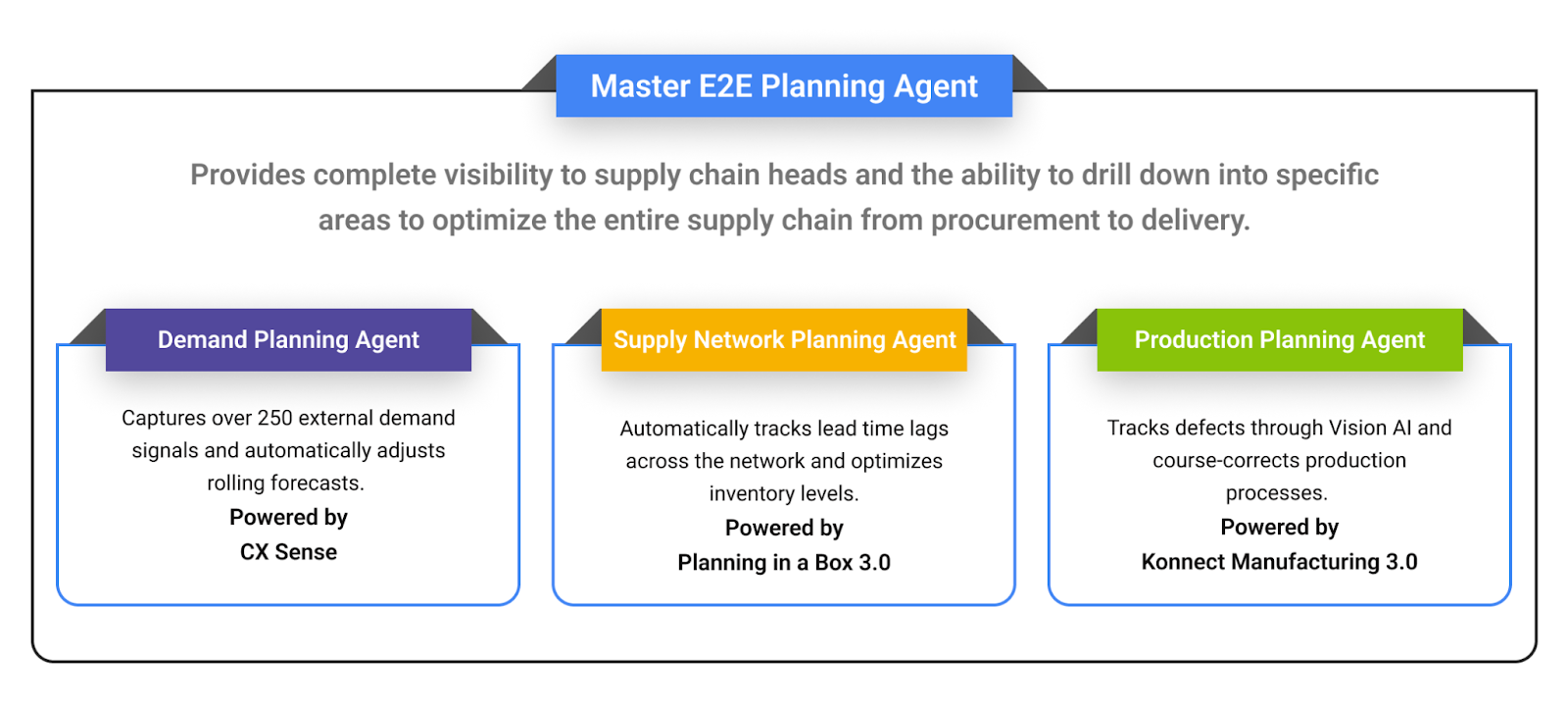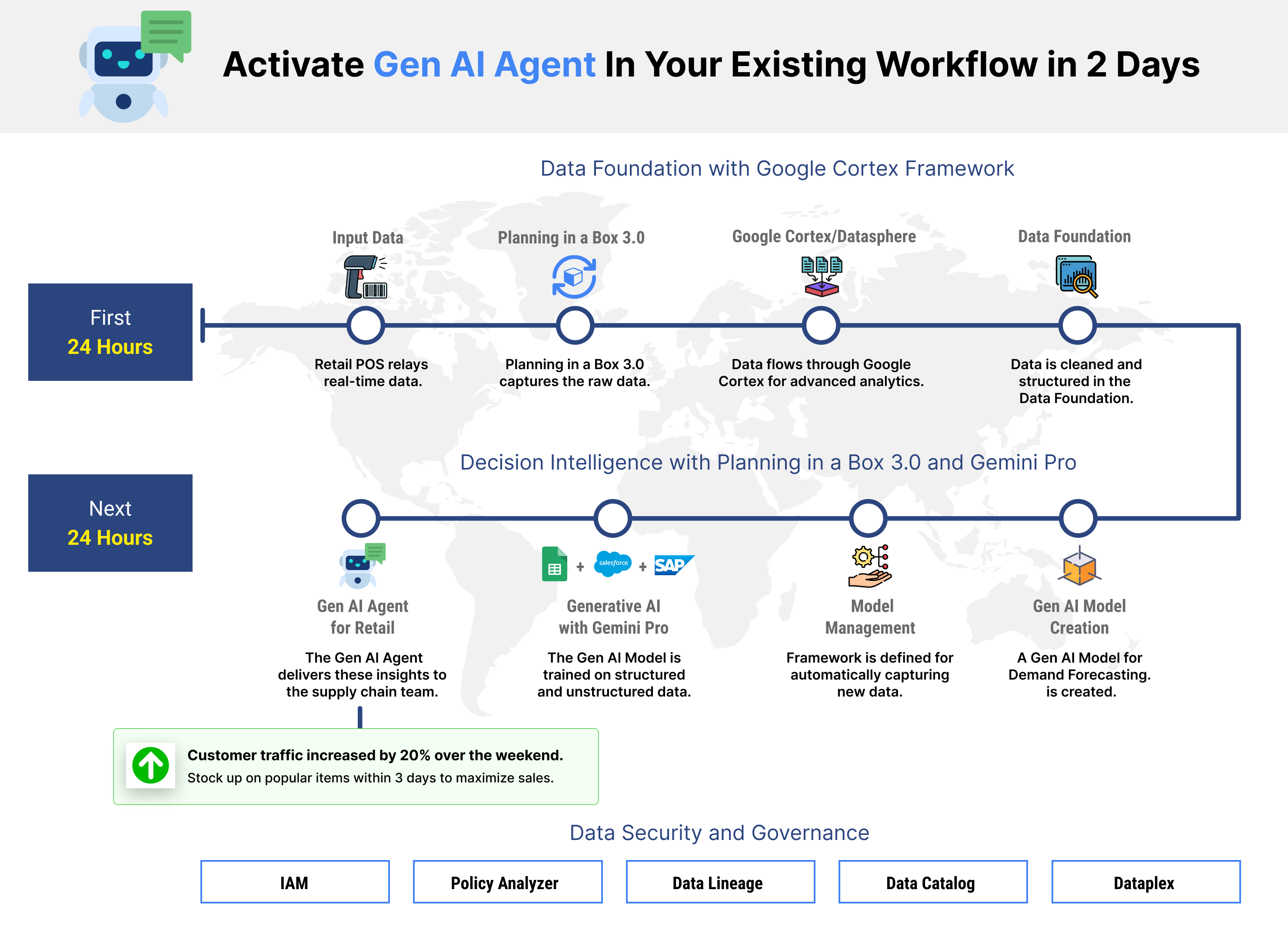
Transform Your Supply Chain Planning and Marketing Strategies with Google Cloud and SAP Integration

Transform Your Supply Chain Planning and Marketing Strategies with Google Cloud and SAP Integration
May 24, 2024 | Premangsu Bhattacharya
Blog / What are Gen AI Agents, and How Do They Impact Supply Chain Planning?
When exploring AI, you’ll often encounter terms like “Generative AI Agents” and “Large language models” (LLMs). Both are powerful tools, but they serve different purposes and are tailored for specific tasks, including those in the supply chain.
Large Language Models, like Google’s Gemini Pro, specialize in understanding and generating text. They excel at digesting extensive text data and responding to queries with accurate textual outputs. For supply chain applications, LLMs can automate documentation, generate reports, or facilitate communication across different parts of the supply chain by processing inquiries and providing information efficiently.
Generative AI Agents are designed to interact dynamically with their environment and users. Think of them as the workers on the factory floor or in warehouses who not only perform tasks but also react to changes, learn from interactions, and even initiate actions based on real-time data. In the context of the supply chain, these agents can manage inventory, handle customer service interactions, and oversee logistics operations, adapting as conditions change.
Generative AI Agents build on what LLMs can do by automating entire workflows. These agents excel in responding to changes in real-time by integrating external signals like market trends directly into the operational workflow. For instance, if a product suddenly becomes popular on social media, the agent can quickly adjust inventory forecasts and supplier orders to meet the increased demand. This means stores have just the right amount of stock without needing a person to make changes manually.
In the following example, Pluto7’s Gen AI agent connects real–time data across multiple departments, as shown in the image. This includes sales, marketing, finance, supply chain, and manufacturing. They help users find quick answers to natural language questions such as:

For a deep dive into Pluto7’s Gen AI Agents, head to this page.

Image Attribution: Image by drobotdean on Freepik.
Let’s look at the following example.
A leading tech company experiences critical stockouts of new fitness trackers during January—a peak purchasing month driven by New Year’s resolutions. Despite operating 200 stores across the U.S., their forecasting models fail to predict the sudden surge in demand accurately, especially in urban areas where health trends quickly gain traction.
Core Issues:
The challenges this company faces are all too common in the retail industry. Now, let’s imagine a different scenario. What if this company had integrated Pluto7’s CX Sense Gen AI Agent into their demand planning process? This intelligent agent could capture real-time signals, such as spikes in social media activity, and integrate them into the company’s forecasting models. Let’s discuss how CX Sense would address and solve the identified issues.

The biggest upside to Gen AI agents is the productivity gain. With this agent, planners can get more done with less effort, allowing them to focus on strategic decision-making and innovation.
| Manual Work | CX Sense Gen AI Agent | |
|---|---|---|
| Collecting POS and Social Media Data | 6 hours daily, multiple team members | Real-time, completely automated |
| Merging Data from Different Sources | 1-2 days per week, 2 data analysts | Real-time, completely automated |
| Adjusting Demand Forecasts | 8-10 hours per forecast cycle, 1 data analyst | Instant, completely automated |
| Reviewing & Adjusting Inventory Levels | 4-6 hours per week, 1 inventory manager | Real-time, completely automated |
| Monitoring Market Trends | 3-4 hours daily, 2 marketing team members | Real-time, completely automated |
Great in concept, but will it actually work in your current setup? If this question is on your mind, I invite you to a free workshop with me and my team. We will bring in all the tools and tech; you bring just the business problem you are trying to solve. In a single 1-hour session, we will brainstorm and arrive at a solution that fits your needs.
Sign up for the Workshop Here.
Let’s work together to make your operations more efficient and your business more profitable.
ABOUT THE AUTHOR